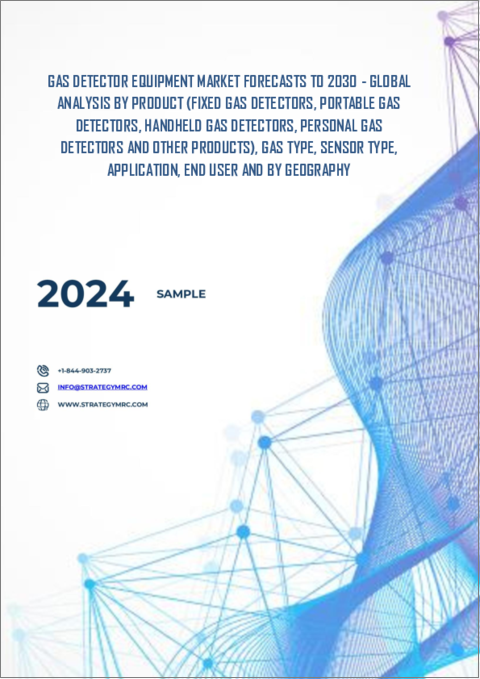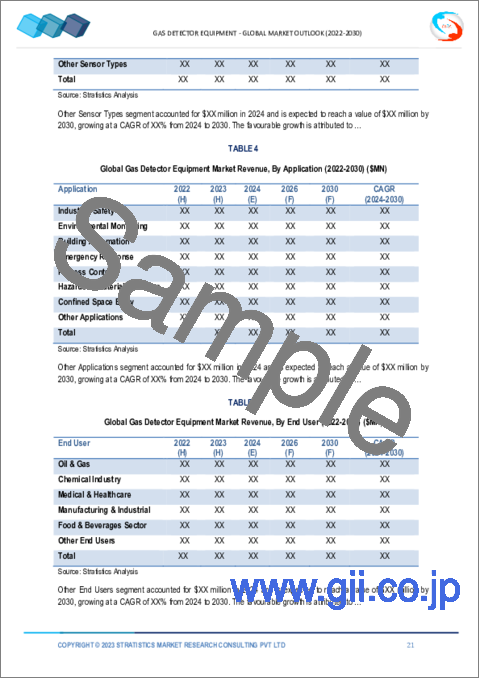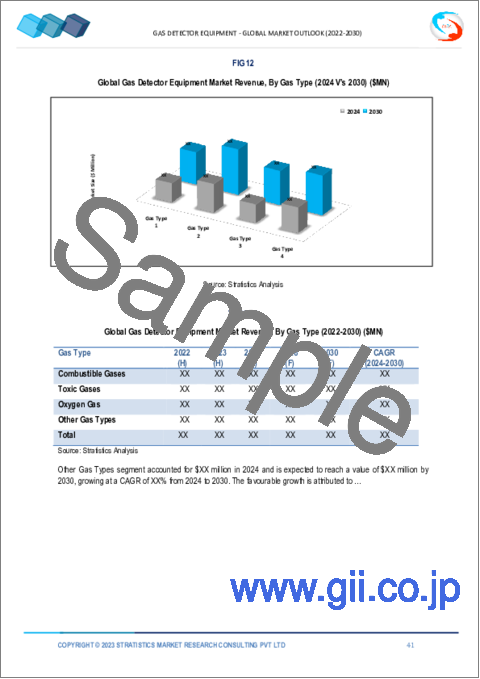|
|
市場調査レポート
商品コード
1494792
ガス検知器の2030年までの市場予測:製品タイプ、ガスタイプ、センサータイプ、用途、エンドユーザー、地域別の世界分析Gas Detector Equipment Market Forecasts to 2030 - Global Analysis By Product (Fixed Gas Detectors, Portable Gas Detectors, Handheld Gas Detectors, Personal Gas Detectors and Other Products), Gas Type, Sensor Type, Application, End User and By Geography |
||||||
カスタマイズ可能
|
|||||||
| ガス検知器の2030年までの市場予測:製品タイプ、ガスタイプ、センサータイプ、用途、エンドユーザー、地域別の世界分析 |
|
出版日: 2024年06月06日
発行: Stratistics Market Research Consulting
ページ情報: 英文 200+ Pages
納期: 2~3営業日
|
全表示
- 概要
- 図表
- 目次
Stratistics MRCによると、ガス検知器の世界市場は2024年に56億8,000万米ドルを占め、予測期間中のCAGRは7.2%で成長し、2030年には76億1,000万米ドルに達する見込みです。
ガス検知器は、エリア内のガスの存在を検知するための装置であり、多くの場合、安全システムの一部として使用されます。これらの装置は、危険なガス漏れを特定し、作業員の安全を確保し、潜在的な爆発や健康リスクを防止するために不可欠です。赤外線センサー、超音波センサー、電気化学センサー、半導体センサーなど、さまざまなセンシング技術を駆使して作動し、危険なガス濃度をリアルタイムで監視・警告します。
国連の2018年人権理事会報告書によると、危険ガスへの暴露は年間約280万人の従業員に影響を及ぼしています。
都市化とインフラ整備
都市部が拡大し、インフラプロジェクトが急増するにつれ、労働者、住民、資産の安全を確保する必要性が高まっています。ガス検知器は、有害ガスの監視、潜在的な事故の防止、安全規制の遵守において重要な役割を果たしています。その結果、都市化とインフラ開拓の急増がガス検知器の採用を後押しし、建設、運輸、公益事業などさまざまな分野での市場拡大を促進しています。
技術的複雑性
ガス検知器の技術的な複雑さには、主に高度な検知技術の複雑さと既存システムへの統合が含まれます。これらの複雑さには、校正要件、異なるガスとの互換性の問題、操作と保守のための専門的トレーニングの必要性などが含まれます。その結果、技術的な複雑さや関連する導入課題への懸念から、こうしたソリューションへの投資をためらう業界もあり、市場の成長が妨げられる可能性があります。
ガス漏れの多発
知名度の高い事故は潜在的な危険性を強調し、産業界はリスクを軽減するために信頼性の高い検知システムへの投資を促しています。その結果、ガス漏れの早期発見と対応を確実にするため、リアルタイムの監視機能を備えた高度なガス検知器に対する需要が高まっています。この動向は、企業が人員、資産、環境を保護するための強固な安全プロトコルの導入を優先するため、市場の成長を促進します。
高いメンテナンスと校正コスト
ガス検知器の保守・校正コストが高いのは、正確で信頼性の高い性能を確保するために定期的な整備が必要なためです。これらのコストには、人件費、専用工具、交換部品が含まれます。さらに、校正プロセスには時間がかかり、訓練を受けた担当者が必要となります。メンテナンスと校正のための継続的な費用が高額になると、潜在的な購入者、特に小規模の企業や厳しい予算で運営されている企業は、ガス検知機器への投資を思いとどまる可能性があります。
COVID-19の影響
COVID-19パンデミックは、サプライチェーンの混乱、製造およびプロジェクト・スケジュールの遅延、影響を受けた業界における資本支出の減少によって、ガス検知器機器市場に影響を与えました。しかし、基幹産業における労働者の安全への関心の高まりと厳格な衛生規制が安定した需要を維持しました。パンデミック後の復興努力と産業の成長は、高度な安全性と監視システムの必要性を強調し、市場の復活を後押しすると予想されます。
予測期間中、ポータブルガス検知器セグメントが最大になる見込み
ポータブルガス検知器分野は、有利な成長が見込まれます。ポータブルガス検知器は、様々な環境における危険ガスレベルを検知・監視するために設計されたコンパクトなモバイル機器です。石油・ガス、鉱業、製造業などの産業で広く使用されており、有毒ガスや可燃性ガスの存在をリアルタイムで警告することで、作業員の安全性を高めています。主な特徴としては、使いやすさ、信頼性、高度なセンサー技術などがあり、狭い場所や遠隔地でも迅速かつ正確に検知することができます。
緊急対応分野は予測期間中に最も高いCAGRが見込まれる
緊急対応分野は、予測期間中に最も高いCAGR成長が見込まれています。ガス検知器は、化学物質の流出、火災、ガス漏れなどの事故時に危険ガスのリアルタイムモニタリングと検知を提供する、緊急対応アプリケーションにおいて極めて重要です。これらの機器は、第一応答者がガスの危険性を迅速に特定、評価できるようにし、タイムリーな避難、封じ込め、緩和活動を可能にします。携帯性、耐久性、高度なセンサー技術を特徴とするガス検知器は、重要でリスクの高い状況における安全性と効率を高める。
最大のシェアを占める地域
アジア太平洋地域は、急速な工業化、厳しい安全規制、職場の安全に対する意識の高まりにより、予測期間中最大の市場シェアを占めると予測されます。中国、インド、日本、韓国などの国々は、製造業、石油・ガス、鉱業部門が盛んであるため、市場拡大に大きく貢献しています。また、インフラプロジェクトへの投資が増加していることも、ガス検知器の需要をさらに押し上げています。
CAGRが最も高い地域:
北米が予測期間で最もCAGRが高いと予測されています。石油・ガス、鉱業、工業製造などの主要セクターがこの地域の需要に大きく貢献しています。同市場の主要プレーヤーには、Honeywell International、MSA Safety、Dragerwerk AGなどがあります。米国が市場を独占し、インフラとエネルギー・プロジェクトに多額の投資を行っているカナダがこれに続く。自動化とスマート安全システムへの動向が、この地域での市場拡大をさらに後押ししています。
無料のカスタマイズサービス:
本レポートをご購読のお客様には、以下の無料カスタマイズオプションのいずれかをご利用いただけます:
- 企業プロファイル
- 追加市場プレイヤーの包括的プロファイリング(3社まで)
- 主要企業のSWOT分析(3社まで)
- 地域セグメンテーション
- 顧客の関心に応じた主要国の市場推計・予測・CAGR(注:フィージビリティチェックによる)
- 競合ベンチマーキング
- 製品ポートフォリオ、地理的プレゼンス、戦略的提携に基づく主要企業のベンチマーキング
目次
第1章 エグゼクティブサマリー
第2章 序文
- 概要
- ステークホルダー
- 調査範囲
- 調査手法
- データマイニング
- データ分析
- データ検証
- 調査アプローチ
- 調査情報源
- 1次調査情報源
- 2次調査情報源
- 前提条件
第3章 市場動向分析
- 促進要因
- 抑制要因
- 機会
- 脅威
- 製品分析
- 用途分析
- エンドユーザー分析
- 新興市場
- COVID-19の影響
第4章 ポーターのファイブフォース分析
- 供給企業の交渉力
- 買い手の交渉力
- 代替品の脅威
- 新規参入業者の脅威
- 競争企業間の敵対関係
第5章 世界のガス検知器市場:製品別
- 固定式ガス検知器
- ポータブルガス検知器
- ハンドヘルドガス検知器
- 個人用ガス検知器
- その他の製品
第6章 世界のガス検知器市場:ガスタイプ別
- 可燃性ガス
- 有毒ガス
- 酸素ガス
- その他のガスタイプ
第7章 世界のガス検知器市場:センサータイプ別
- 電気化学センサー
- 赤外線センサー
- 触媒センサー
- 光イオン化検出器(PID)
- 半導体センサー
- 超音波センサー
- その他のセンサータイプ
第8章 世界のガス検知器市場:用途別
- 産業安全
- 環境モニタリング
- ビルオートメーション
- 緊急対応
- プロセス制御
- 危険物質検出
- 閉鎖空間への進入
- その他の用途
第9章 世界のガス検知器市場:エンドユーザー別
- 石油ガス
- 化学工業
- 医療・ヘルスケア
- 製造業および工業
- 食品・飲料部門
- その他のエンドユーザー
第10章 世界のガス検知器市場:地域別
- 北米
- 米国
- カナダ
- メキシコ
- 欧州
- ドイツ
- 英国
- イタリア
- フランス
- スペイン
- その他欧州
- アジア太平洋地域
- 日本
- 中国
- インド
- オーストラリア
- ニュージーランド
- 韓国
- その他アジア太平洋地域
- 南米
- アルゼンチン
- ブラジル
- チリ
- その他南米
- 中東・アフリカ
- サウジアラビア
- アラブ首長国連邦
- カタール
- 南アフリカ
- その他中東とアフリカ
第11章 主な発展
- 契約、パートナーシップ、コラボレーション、合弁事業
- 買収と合併
- 新製品発売
- 事業拡大
- その他の主要戦略
第12章 企業プロファイリング
- Honeywell International Inc.
- MSA Safety Incorporated
- Dragerwerk AG & Co. KGaA
- Industrial Scientific Corporation
- Riken Keiki Corporation
- New Cosmos Electric Corporation
- Siemens AG
- Emerson Electric Corporation
- Thermo Fisher Scientific Inc.
- RAE Systems Inc.
- Sensit Technologies
- Crowcon Detection Instruments Limited
- Testo SE & Co. KGaA
- Yokogawa Electric Corporation
- Trolex Limited
- Sierra Monitor Corporation
- Teledyne Technologies Incorporated
- GfG Instrumentation Inc.
- FLIR Corporation
- CO2Meter
List of Tables
- Table 1 Global Gas Detector Equipment Market Outlook, By Region (2022-2030) ($MN)
- Table 2 Global Gas Detector Equipment Market Outlook, By Product (2022-2030) ($MN)
- Table 3 Global Gas Detector Equipment Market Outlook, By Fixed Gas Detectors (2022-2030) ($MN)
- Table 4 Global Gas Detector Equipment Market Outlook, By Portable Gas Detectors (2022-2030) ($MN)
- Table 5 Global Gas Detector Equipment Market Outlook, By Handheld Gas Detectors (2022-2030) ($MN)
- Table 6 Global Gas Detector Equipment Market Outlook, By Personal Gas Detectors (2022-2030) ($MN)
- Table 7 Global Gas Detector Equipment Market Outlook, By Other Products (2022-2030) ($MN)
- Table 8 Global Gas Detector Equipment Market Outlook, By Gas Type (2022-2030) ($MN)
- Table 9 Global Gas Detector Equipment Market Outlook, By Combustible Gases (2022-2030) ($MN)
- Table 10 Global Gas Detector Equipment Market Outlook, By Toxic Gases (2022-2030) ($MN)
- Table 11 Global Gas Detector Equipment Market Outlook, By Oxygen Gas (2022-2030) ($MN)
- Table 12 Global Gas Detector Equipment Market Outlook, By Other Gas Types (2022-2030) ($MN)
- Table 13 Global Gas Detector Equipment Market Outlook, By Sensor Type (2022-2030) ($MN)
- Table 14 Global Gas Detector Equipment Market Outlook, By Electrochemical Sensors (2022-2030) ($MN)
- Table 15 Global Gas Detector Equipment Market Outlook, By Infrared Sensors (2022-2030) ($MN)
- Table 16 Global Gas Detector Equipment Market Outlook, By Catalytic Sensors (2022-2030) ($MN)
- Table 17 Global Gas Detector Equipment Market Outlook, By Photo Ionization Detectors (PID) (2022-2030) ($MN)
- Table 18 Global Gas Detector Equipment Market Outlook, By Semiconductor Sensors (2022-2030) ($MN)
- Table 19 Global Gas Detector Equipment Market Outlook, By Ultrasonic Sensors (2022-2030) ($MN)
- Table 20 Global Gas Detector Equipment Market Outlook, By Other Sensor Types (2022-2030) ($MN)
- Table 21 Global Gas Detector Equipment Market Outlook, By Application (2022-2030) ($MN)
- Table 22 Global Gas Detector Equipment Market Outlook, By Industrial Safety (2022-2030) ($MN)
- Table 23 Global Gas Detector Equipment Market Outlook, By Environmental Monitoring (2022-2030) ($MN)
- Table 24 Global Gas Detector Equipment Market Outlook, By Building Automation (2022-2030) ($MN)
- Table 25 Global Gas Detector Equipment Market Outlook, By Emergency Response (2022-2030) ($MN)
- Table 26 Global Gas Detector Equipment Market Outlook, By Process Control (2022-2030) ($MN)
- Table 27 Global Gas Detector Equipment Market Outlook, By Hazardous Material Detection (2022-2030) ($MN)
- Table 28 Global Gas Detector Equipment Market Outlook, By Confined Space Entry (2022-2030) ($MN)
- Table 29 Global Gas Detector Equipment Market Outlook, By Other Applications (2022-2030) ($MN)
- Table 30 Global Gas Detector Equipment Market Outlook, By End User (2022-2030) ($MN)
- Table 31 Global Gas Detector Equipment Market Outlook, By Oil & Gas (2022-2030) ($MN)
- Table 32 Global Gas Detector Equipment Market Outlook, By Chemical Industry (2022-2030) ($MN)
- Table 33 Global Gas Detector Equipment Market Outlook, By Medical & Healthcare (2022-2030) ($MN)
- Table 34 Global Gas Detector Equipment Market Outlook, By Manufacturing & Industrial (2022-2030) ($MN)
- Table 35 Global Gas Detector Equipment Market Outlook, By Food & Beverages Sector (2022-2030) ($MN)
- Table 36 Global Gas Detector Equipment Market Outlook, By Other End Users (2022-2030) ($MN)
Note: Tables for North America, Europe, APAC, South America, and Middle East & Africa Regions are also represented in the same manner as above.
According to Stratistics MRC, the Global Gas Detector Equipment Market is accounted for $5.68 billion in 2024 and is expected to reach $7.61 billion by 2030 growing at a CAGR of 7.2% during the forecast period. Gas detector equipment is a device used to detect the presence of gases in an area, often as part of a safety system. These devices are essential for identifying hazardous gas leaks, ensuring worker safety, and preventing potential explosions or health risks. They operate using various sensing technologies, including infrared, ultrasonic, electrochemical, and semiconductor sensors, to provide real-time monitoring and alerts for dangerous gas concentrations.
According to the United Nations' 2018 report to the Human Rights Council, hazardous gas exposure affects around 2.8 million employees annually.
Market Dynamics:
Driver:
Urbanization and infrastructure development
As urban areas expand and infrastructure projects proliferate, there's a heightened need to ensure the safety of workers, residents, and assets. Gas detectors play a crucial role in monitoring for hazardous gases, preventing potential accidents, and complying with safety regulations. Consequently, the surge in urbanization and infrastructure development drives the adoption of gas detection equipment, fostering market expansion in various sectors such as construction, transportation, and utilities.
Restraint:
Technological complexities
Technological complexities in gas detector equipment primarily involve the intricacies of advanced detection technologies and their integration into existing systems. These complexities include calibration requirements, compatibility issues with different gases, and the need for specialized training for operation and maintenance. As a result, the market growth may be hindered as some industries may hesitate to invest in these solutions due to concerns about technological complexities and associated implementation challenges.
Opportunity:
Mounting incidence of gas leaks
High-profile accidents underscore the potential dangers, prompting industries to invest in reliable detection systems to mitigate risks. Consequently, there is a growing demand for advanced gas detection equipment with real-time monitoring capabilities to ensure early detection and response to gas leaks. This trend propels market growth as companies prioritize the implementation of robust safety protocols to safeguard personnel, assets, and the environment.
Threat:
High maintenance and calibration costs
High maintenance and calibration costs in gas detector equipment stem from the need for regular servicing to ensure accurate and reliable performance. These costs include labor, specialized tools, and replacement parts. Additionally, calibration processes can be time-consuming and require trained personnel. High ongoing expenses for maintenance and calibration may deter potential buyers, particularly smaller enterprises or those operating on tight budgets, from investing in gas detection equipment.
Covid-19 Impact
The covid-19 pandemic impacted the gas detector equipment market by causing supply chain disruptions, delaying manufacturing and project timelines, and reducing capital expenditures in affected industries. However, increased focus on worker safety and stringent health regulations in essential industries maintained steady demand. Post-pandemic recovery efforts and industrial growth are expected to bolster market resurgence, emphasizing the need for advanced safety and monitoring systems.
The portable gas detectors segment is expected to be the largest during the forecast period
The portable gas detectors segment is estimated to have a lucrative growth. Portable gas detectors are compact, mobile devices designed to detect and monitor hazardous gas levels in various environments. Widely used in industries like oil and gas, mining, and manufacturing, these detectors enhance worker safety by providing real-time alerts to the presence of toxic or flammable gases. Key features include ease of use, reliability, and advanced sensor technology, enabling quick and accurate detection in confined spaces and remote locations.
The emergency response segment is expected to have the highest CAGR during the forecast period
The emergency response segment is anticipated to witness the highest CAGR growth during the forecast period. Gas detector equipment is crucial in emergency response applications, providing real-time monitoring and detection of hazardous gases during incidents like chemical spills, fires, and gas leaks. These devices ensure first responders can quickly identify and assess gas hazards, enabling timely evacuation, containment, and mitigation efforts. Featuring portability, durability, and advanced sensor technology, gas detectors enhance safety and efficiency in critical, high-risk situations.
Region with largest share:
Asia Pacific is projected to hold the largest market share during the forecast period driven by rapid industrialization, stringent safety regulations, and increasing awareness about workplace safety. Countries like China, India, Japan, and South Korea are leading contributors to market expansion due to their thriving manufacturing, oil and gas, and mining sectors. Additionally, growing investments in infrastructure projects further propel the demand for gas detection equipment.
Region with highest CAGR:
North America is projected to have the highest CAGR over the forecast period. Key sectors such as oil and gas, mining, and industrial manufacturing are major contributors to demand in the region. Major players in the market include Honeywell International, MSA Safety, and Dragerwerk AG. The U.S. dominates the market, followed by Canada, with significant investments in infrastructure and energy projects. The trend towards automation and smart safety systems further propels market expansion in the region.
Key players in the market
Some of the key players profiled in the Gas Detector Equipment Market include Honeywell International Inc., MSA Safety Incorporated, Dragerwerk AG & Co. KGaA, Industrial Scientific Corporation, Riken Keiki Corporation, New Cosmos Electric Corporation, Siemens AG, Emerson Electric Corporation, Thermo Fisher Scientific Inc., RAE Systems Inc., Sensit Technologies, Crowcon Detection Instruments Limited, Testo SE & Co. KGaA, Yokogawa Electric Corporation, Trolex Limited, Sierra Monitor Corporation, Teledyne Technologies Incorporated, GfG Instrumentation Inc., FLIR Corporation, CO2Meter.
Key Developments:
In May 2024, CO2Meter has released an industrial gas detector designed to monitor gases across a multitude of industrial environments. The highly anticipated industrial gas safety series will measure either oxygen or carbon dioxide, protecting employees working near and around hazardous gases in the field.
In January 2024, Teledyne launched iTrans 2 fixed gas detector that offers smart sensor capabilities that support an intelligent electronics platform, and provides one or two points of detection from a single head for maximum flexibility, with both readings shown on the standard-issue, LED and display.
Products Covered:
- Fixed Gas Detectors
- Portable Gas Detectors
- Handheld Gas Detectors
- Personal Gas Detectors
- Other Products
Gas Types Covered:
- Combustible Gases
- Toxic Gases
- Oxygen Gas
- Other Gas Types
Sensor Types Covered:
- Electrochemical Sensors
- Infrared Sensors
- Catalytic Sensors
- Photo Ionization Detectors (PID)
- Semiconductor Sensors
- Ultrasonic Sensors
- Other Sensor Types
Applications Covered:
- Industrial Safety
- Environmental Monitoring
- Building Automation
- Emergency Response
- Process Control
- Hazardous Material Detection
- Confined Space Entry
- Other Applications
End Users Covered:
- Oil & Gas
- Chemical Industry
- Medical & Healthcare
- Manufacturing & Industrial
- Food & Beverages Sector
- Other End Users
Regions Covered:
- North America
- US
- Canada
- Mexico
- Europe
- Germany
- UK
- Italy
- France
- Spain
- Rest of Europe
- Asia Pacific
- Japan
- China
- India
- Australia
- New Zealand
- South Korea
- Rest of Asia Pacific
- South America
- Argentina
- Brazil
- Chile
- Rest of South America
- Middle East & Africa
- Saudi Arabia
- UAE
- Qatar
- South Africa
- Rest of Middle East & Africa
What our report offers:
- Market share assessments for the regional and country-level segments
- Strategic recommendations for the new entrants
- Covers Market data for the years 2022, 2023, 2024, 2026, and 2030
- Market Trends (Drivers, Constraints, Opportunities, Threats, Challenges, Investment Opportunities, and recommendations)
- Strategic recommendations in key business segments based on the market estimations
- Competitive landscaping mapping the key common trends
- Company profiling with detailed strategies, financials, and recent developments
- Supply chain trends mapping the latest technological advancements
Free Customization Offerings:
All the customers of this report will be entitled to receive one of the following free customization options:
- Company Profiling
- Comprehensive profiling of additional market players (up to 3)
- SWOT Analysis of key players (up to 3)
- Regional Segmentation
- Market estimations, Forecasts and CAGR of any prominent country as per the client's interest (Note: Depends on feasibility check)
- Competitive Benchmarking
- Benchmarking of key players based on product portfolio, geographical presence, and strategic alliances
Table of Contents
1 Executive Summary
2 Preface
- 2.1 Abstract
- 2.2 Stake Holders
- 2.3 Research Scope
- 2.4 Research Methodology
- 2.4.1 Data Mining
- 2.4.2 Data Analysis
- 2.4.3 Data Validation
- 2.4.4 Research Approach
- 2.5 Research Sources
- 2.5.1 Primary Research Sources
- 2.5.2 Secondary Research Sources
- 2.5.3 Assumptions
3 Market Trend Analysis
- 3.1 Introduction
- 3.2 Drivers
- 3.3 Restraints
- 3.4 Opportunities
- 3.5 Threats
- 3.6 Product Analysis
- 3.7 Application Analysis
- 3.8 End User Analysis
- 3.9 Emerging Markets
- 3.10 Impact of Covid-19
4 Porters Five Force Analysis
- 4.1 Bargaining power of suppliers
- 4.2 Bargaining power of buyers
- 4.3 Threat of substitutes
- 4.4 Threat of new entrants
- 4.5 Competitive rivalry
5 Global Gas Detector Equipment Market, By Product
- 5.1 Introduction
- 5.2 Fixed Gas Detectors
- 5.3 Portable Gas Detectors
- 5.4 Handheld Gas Detectors
- 5.5 Personal Gas Detectors
- 5.6 Other Products
6 Global Gas Detector Equipment Market, By Gas Type
- 6.1 Introduction
- 6.2 Combustible Gases
- 6.3 Toxic Gases
- 6.4 Oxygen Gas
- 6.5 Other Gas Types
7 Global Gas Detector Equipment Market, By Sensor Type
- 7.1 Introduction
- 7.2 Electrochemical Sensors
- 7.3 Infrared Sensors
- 7.4 Catalytic Sensors
- 7.5 Photo Ionization Detectors (PID)
- 7.6 Semiconductor Sensors
- 7.7 Ultrasonic Sensors
- 7.8 Other Sensor Types
8 Global Gas Detector Equipment Market, By Application
- 8.1 Introduction
- 8.2 Industrial Safety
- 8.3 Environmental Monitoring
- 8.4 Building Automation
- 8.5 Emergency Response
- 8.6 Process Control
- 8.7 Hazardous Material Detection
- 8.8 Confined Space Entry
- 8.9 Other Applications
9 Global Gas Detector Equipment Market, By End User
- 9.1 Introduction
- 9.2 Oil & Gas
- 9.3 Chemical Industry
- 9.4 Medical & Healthcare
- 9.5 Manufacturing & Industrial
- 9.6 Food & Beverages Sector
- 9.7 Other End Users
10 Global Gas Detector Equipment Market, By Geography
- 10.1 Introduction
- 10.2 North America
- 10.2.1 US
- 10.2.2 Canada
- 10.2.3 Mexico
- 10.3 Europe
- 10.3.1 Germany
- 10.3.2 UK
- 10.3.3 Italy
- 10.3.4 France
- 10.3.5 Spain
- 10.3.6 Rest of Europe
- 10.4 Asia Pacific
- 10.4.1 Japan
- 10.4.2 China
- 10.4.3 India
- 10.4.4 Australia
- 10.4.5 New Zealand
- 10.4.6 South Korea
- 10.4.7 Rest of Asia Pacific
- 10.5 South America
- 10.5.1 Argentina
- 10.5.2 Brazil
- 10.5.3 Chile
- 10.5.4 Rest of South America
- 10.6 Middle East & Africa
- 10.6.1 Saudi Arabia
- 10.6.2 UAE
- 10.6.3 Qatar
- 10.6.4 South Africa
- 10.6.5 Rest of Middle East & Africa
11 Key Developments
- 11.1 Agreements, Partnerships, Collaborations and Joint Ventures
- 11.2 Acquisitions & Mergers
- 11.3 New Product Launch
- 11.4 Expansions
- 11.5 Other Key Strategies
12 Company Profiling
- 12.1 Honeywell International Inc.
- 12.2 MSA Safety Incorporated
- 12.3 Dragerwerk AG & Co. KGaA
- 12.4 Industrial Scientific Corporation
- 12.5 Riken Keiki Corporation
- 12.6 New Cosmos Electric Corporation
- 12.7 Siemens AG
- 12.8 Emerson Electric Corporation
- 12.9 Thermo Fisher Scientific Inc.
- 12.10 RAE Systems Inc.
- 12.11 Sensit Technologies
- 12.12 Crowcon Detection Instruments Limited
- 12.13 Testo SE & Co. KGaA
- 12.14 Yokogawa Electric Corporation
- 12.15 Trolex Limited
- 12.16 Sierra Monitor Corporation
- 12.17 Teledyne Technologies Incorporated
- 12.18 GfG Instrumentation Inc.
- 12.19 FLIR Corporation
- 12.20 CO2Meter






